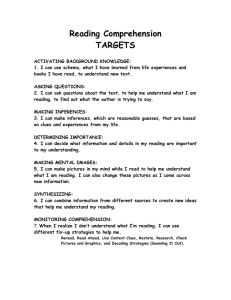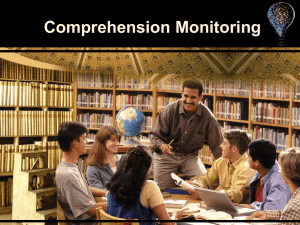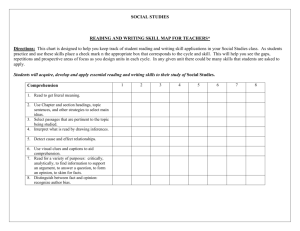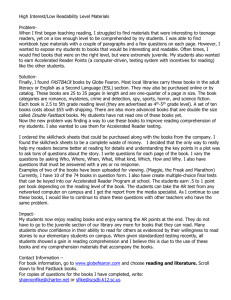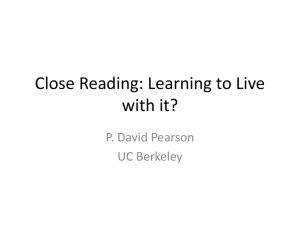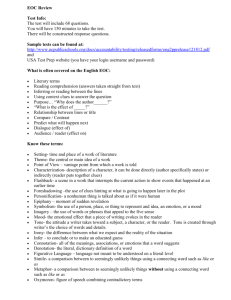Tips for Analyzing the Running Record and Comprehension
advertisement
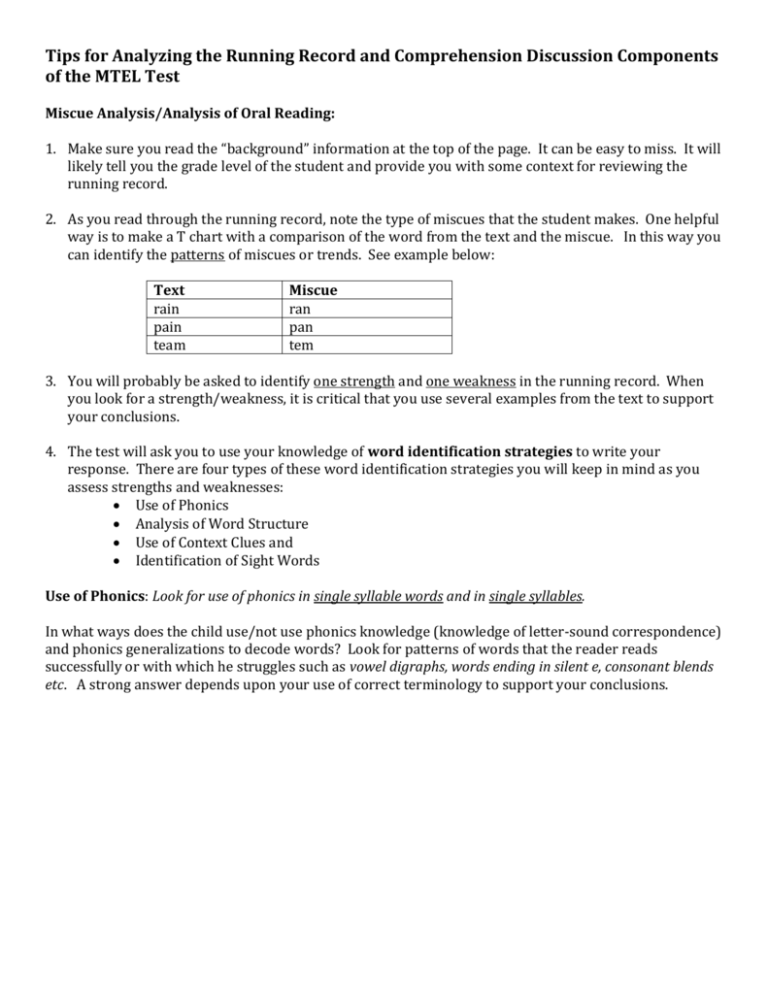
Tips for Analyzing the Running Record and Comprehension Discussion Components of the MTEL Test Miscue Analysis/Analysis of Oral Reading: 1. Make sure you read the “background” information at the top of the page. It can be easy to miss. It will likely tell you the grade level of the student and provide you with some context for reviewing the running record. 2. As you read through the running record, note the type of miscues that the student makes. One helpful way is to make a T chart with a comparison of the word from the text and the miscue. In this way you can identify the patterns of miscues or trends. See example below: Text rain pain team Miscue ran pan tem 3. You will probably be asked to identify one strength and one weakness in the running record. When you look for a strength/weakness, it is critical that you use several examples from the text to support your conclusions. 4. The test will ask you to use your knowledge of word identification strategies to write your response. There are four types of these word identification strategies you will keep in mind as you assess strengths and weaknesses: Use of Phonics Analysis of Word Structure Use of Context Clues and Identification of Sight Words Use of Phonics: Look for use of phonics in single syllable words and in single syllables. In what ways does the child use/not use phonics knowledge (knowledge of letter-sound correspondence) and phonics generalizations to decode words? Look for patterns of words that the reader reads successfully or with which he struggles such as vowel digraphs, words ending in silent e, consonant blends etc. A strong answer depends upon your use of correct terminology to support your conclusions. Analysis of Word Structure (also known as Structural Analysis or Word Analysis): Look for analysis of word structure with multi-syllable words. Consider whether or not the reader has strategies for decoding longer, multi-syllable words. Does the reader break these longer words into more manageable parts by looking for “chunks” or word parts that they know? Does the reader divide these words into their syllables? Compound words into the smaller words from which they’re composed? Accurately read words with inflections (ed, ing, plural endings)? Does the reader use word analysis to divide words into meaning-bearing parts such as prefixes, suffixes, and roots or bases? Remember: The goal is strategy use! Does the reader attempt to read these longer words strategically? Use of Context Clues: Does the reader use context clues to identify an unfamiliar word? Here’s how you can tell that Use of Context Clues is a strength: The reader may SELF-CORRECT © errors by saying to themselves “That didn’t sound right!” or “That didn’t make sense!” Once they apparently notice the error, these readers use context clues to return to the error to self-correct ©. A reader may also have a strength in the use of context clues if they substitute words into the passage that still make sense (use of semantics) and sound right (use of syntax). On the other hand, a reader may have a weakness in the use of context clues if they routinely make substitutions (miscues) that don’t make sense or sound right. They may use the first letter to guess, and then plug away without regard to meaning. * NOTE: If the child’s strength is in the use of context clues, you must then ask yourself the following question: “Why did the child need to use context clues with these words? With which types of words did s/he struggle? Which types of words did s/he initially read incorrectly?” Once you determine a pattern of miscues (usually in the area of phonics or word analysis), you will have also identified your weakness! Identification of Sight Words: Does the reader show automaticity in reading high frequency words? High frequency words that are phonetically “regular” are words such as: am, at, mom, and big. Irregular sight words are words such as because, were, what, said, and the. (See page 73 of the study guide for more examples). These irregular words need to be memorized because they do not follow phonics generalizations. If a child misreads a number of these common words, particularly those with irregular spellings, they show a weakness in this area. WHY IS WORD IDENTIFICATION SO IMPORTANT? In order for a child to read fluently and with comprehension, they need to be “freed” from the burden of decoding unknown words. If they struggle to identify words on the page, they cannot then simultaneously focus on the meaning of the text. Therefore, strong readers need to read with automaticity. Automaticity is required for fluent reading. Fluency is strongly related to comprehension. Answering the Open Response Question related to Comprehension: 1. Read all information carefully! 2. The question will likely read, “Using your knowledge of reading comprehension (e.g. literal comprehension, inferential comprehension, engagement of schema, self monitoring) write a response. . . 3. Be sure that you are familiar with the elements of reading comprehension listed above (and discussed below) and be prepared to provide examples and evidence to support your answer. Literal Comprehension: If the student can repeat back the sequence of events (plot), provide characters, setting etc. stated directly and explicitly in the text, they are using their literal comprehension skills. One way to assess literal comprehension is through an oral retelling. When students retell a fiction passage, they should be able to organize their thinking by beginning, middle, and end. Inferential Comprehension: After considering literal comprehension skills, the next step is to determine if the reader can use clues from the passage to infer what is happening (to “read between the lines” or to look beneath the surface). Students who can ponder/wonder/predict are inferring. They may wonder WHY something happened, or consider WHAT MIGHT happen, or HOW. It is important that these inferences are connected to clear evidence within the passage. It is not enough to provide a creative or reasonable response if it is not connected to the text clues. Engagement of Schema: Does the reader show evidence of activating background knowledge? Does the reader use connections (text-to-self, text-to-text, and/or text-to-world) to better understand what he/she is reading? Does the reader show understanding of the vocabulary in the passage? If so, the reader is engaging with his/her schema (background knowledge) to better understand the text. Self-Monitoring: Does the reader show evidence of metacognition? Does s/he apply comprehension strategies (visualization, summarizing, synthesizing, making connections etc) to better understand the text? Is s/he aware of areas where comprehension breaks down and where a strategy is needed to make sense of the text?
